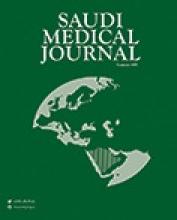Abstract
OBJECTIVE: To assess natural history, treatment outcome and pattern of relapse in patients with maxillary sinus carcinoma.
METHODS: A review was conducted of the medical records of all adult patients with maxillary sinus carcinoma, who were treated at King Faisal Hospital and Research Centre, Riyadh, Kingdom of Saudi Arabia, between January 1990 and December 1999. A total of 60 patients were identified for analysis, 36 men and 24 women; the median age was 58-years (range 23-95). Major presenting symptoms were facial swelling 55%, facial pain 50%, and nasal obstruction 43.4%, with a median duration of 5-months (range 1-24). Histology was quamous cell carcinoma in 71.7% and adenoid cystic in 16.7%. They were restaged according to American Joint Committee on Cancer classification 1997 as II, III and IV in 1, 10 and 49. Thirty patients received treatment with curative intent (surgery in 4 patients, radiotherapy in 2, and combined modality in 24), 6 patients refused treatment and 24 were treated palliatively.
RESULTS: With a median follow up of 50-months (range 2-128) in surviving patients treated with a curative intent, 12/30 failed locally, 4/30 in the regional neck nodes and 2/30 had systemic relapse. The actuarial 5-year overall survival (OS), relapse free survival (RFS) and local control rate (LC) were 55%, 39% and 51%. Treatment modality was the only significant prognostic factor for outcome, with 5 year OS, RFS and LC of 72%, 49% and 61%, for combined modality using surgery followed by radiotherapy compared to 0% for single approach (p=0.0003, p=0.0052 and p=0.0098)
CONCLUSION: This study indicates that the majority of our patients presented with advanced disease, resulting in poor outcome to conventional treatment modalities. Efforts should be directed to minimize the delay in diagnosis at the primary care level. Combined modality treatment should be offered to all patients with locally advanced disease. New approaches such as neoadjuvant or concurrent chemoradiotherapy with or without surgery need to be considered and evaluated in prospective studies.
- Copyright: © Saudi Medical Journal
This is an open-access article distributed under the terms of the Creative Commons Attribution-Noncommercial-Share Alike 3.0 Unported, which permits unrestricted use, distribution, and reproduction in any medium, provided the original work is properly cited.






